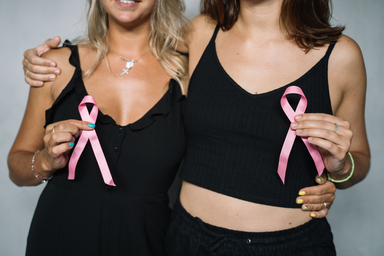It’s October. The month that most people associate with Halloween, fall weather and game days. The month where I sit on the couch and watch another Disney classic while eating the neighborhood kids’ Halloween candy.
While most are focusing on the fun, spooky festivities of the season, others see this month as the time where their illness is represented and acknowledged in the public eye. With pink ribbons and pink sports uniforms planted across the nation, this is a month not just for costumes, but also for breast cancer survivors and breast cancer awareness.
According to BreastCancer.org, 13% of women in the United States will develop an invasive form of breast cancer over the span of their life. That’s one in eight women. This poses a major threat to women’s safety, due to its high association with death in comparison to other cancers.
But issues with this illness don’t simply lie in the diagnosis itself. I find that one of the largest and least discussed problems lies in the issue of not knowing how to identify early signs of breast cancer formation before it spreads.
As a young woman who has a long history of breast cancer in my family, I have always been told to do self-checks and to be on the lookout for anything out-of-the-ordinary with my breasts. But, as I have gotten older and have mentioned self-checks and genetic histories of breast cancer to my close friends, I have noticed that many females have no idea what it means to do a “self-check.” Most importantly, they have no idea what to even look for.
So, that is what this article will focus on. I will cover all the basics, from risks in family history, to self-checks and mammograms, and finally, to the signs of potential cancer growth and development.
FAMILY HISTORY
Family and genetic history is a huge factor in determining the risks of breast cancer. If you know of a family member who has had or is currently living with breast cancer, the risks of developing the same gene are significantly larger than those who don’t have family members with a previous diagnosis.
These risks grow to be five times larger than the average if an individual has a first-degree relative (mother, sister or daughter) who carries the illness, according to BreastCancer.org.
There are several measures you can take to determine your family’s medical history. Many locations allow for genetic testing where they check for the BRCA1 gene or the BRCA2 genes. These are high-risk genetic mutations that have the potential to prompt breast cancer development.
In many cases, some women choose to undergo preventative surgeries when the gene is discovered. If a woman prefers this route of protection, they may remove one or both breasts, or choose to remove their ovaries which are the main source of estrogen in the female body.
This is the more extreme choice for those who feel their chances of diagnosis are greater than not. But, for those who prefer to simply keep an eye on their situation, doctors and medical professionals recommend monthly self-checks, yearly doctor visits and yearly mammograms.
WHAT IS A MAMMOGRAM?
A mammogram is an X-ray photo taken to detect early signs of breast cancer growth, as far out as three years.
The process is fairly quick and consists of one breast at a time being placed on top of a plastic plate with another plate pressing down firmly from the top. As this happens, the machine will take photos of each flattened breast and the X-rays will be sent to a team of radiologists who determine whether or not you are at risk for breast cancer.
Some women find the process to be slightly painful, some find it to be a little uncomfortable and some don’t think it is bad at all. According to the Centers for Disease Control and Prevention, some tips when getting a mammogram are:
- Avoid getting tested if you are on your period. Your breasts may be tender and sore during this time. If this is the time frame your mammogram lands on, you are more likely to experience discomfort and/or pain.
- On the day of the mammogram, do not use deodorant or perfume, due to the high risk that it may appear on the X-ray.
- Wear something practical for the mammogram. Before the X-ray, you will need to undress from the waist up, so most women prefer to wear loose-fitting clothing and/or dresses.
Results from the mammogram can be expected a few weeks after the appointment, but may take up to a month, depending on the circumstances.
If any abnormal issues are detected, doctors and radiologists recommend continuing to get tested and seek advice from medical specialists to determine what to do moving forward. If the breasts appear normal, it is still recommended to continue seeking regular mammograms to ensure that there are no breast cancer genes that were originally undetected.
WHAT ARE SELF-CHECKS? & HOW TO DO THEM
Breast self-exams are a no-cost, convenient and easy way to check for abnormalities in the breasts. It is recommended that self-exams are done regularly each month to increase the odds of early detection and to ensure one’s peace of mind.
According to BreastCancer.org, there are five steps to the self-examination process:
- Stand facing the mirror with your hands on your hips and your shoulders back. In this position, you should look for any discoloration, unusual size and shape, distortion and/or swelling.
- Next, put your arms up and check your breasts and look for any characteristics stated previously in step one.
- Stay in the same position as step two and check for any fluid coming from the nipple. If there is a watery, yellow, milky or blood-like liquid substance, consider talking to your doctor.
- Lay down on your back and firmly press on the breast in a circular motion with the first few finger pads of your hand. In this position, you are searching for any abnormal bumps or cyst-like growths under the skin. To be thorough, you are supposed to go all around the breast tissue on top of the breast and all the way to the armpit and collar bones.
- In this step, you are to repeat the same process as step four, but in an upright position while firmly pressing on each breast in circular motions. Many women like to do this method while in this shower because their skin is wet and allows for less friction when applying such pressure. But, it does not matter whether or not you choose this method.
If you find any bumps or abnormalities, do not fret. It is very normal to have texture and lumps within the breast. If you feel that there is a chance something may lead to a more serious issue, do not be afraid to reach out to a doctor. That is what they are for, and it does not hurt to be safe.
I hope that these tips and tricks help you to be more conscious of your overall health and your ability to catch breast cancer before it spreads.
It is so important to be aware of your body and the changes happening with it. Whether it be natural shifts in the body from age, or strange lumps and bumps growing in your breasts, it is crucial to know if something is just a temporary abnormality or a fatal risk to your well-being.
If you have any concerns about the risks associated with breast cancer and your personal/family health, please seek medical professionals to help schedule you for screenings and tests.


